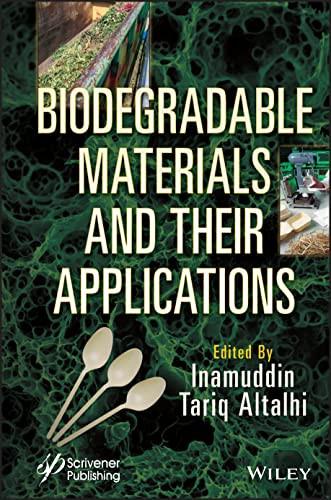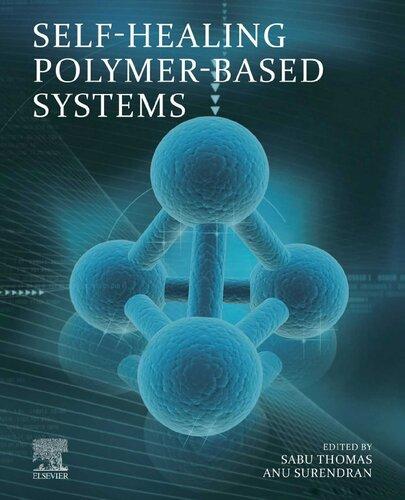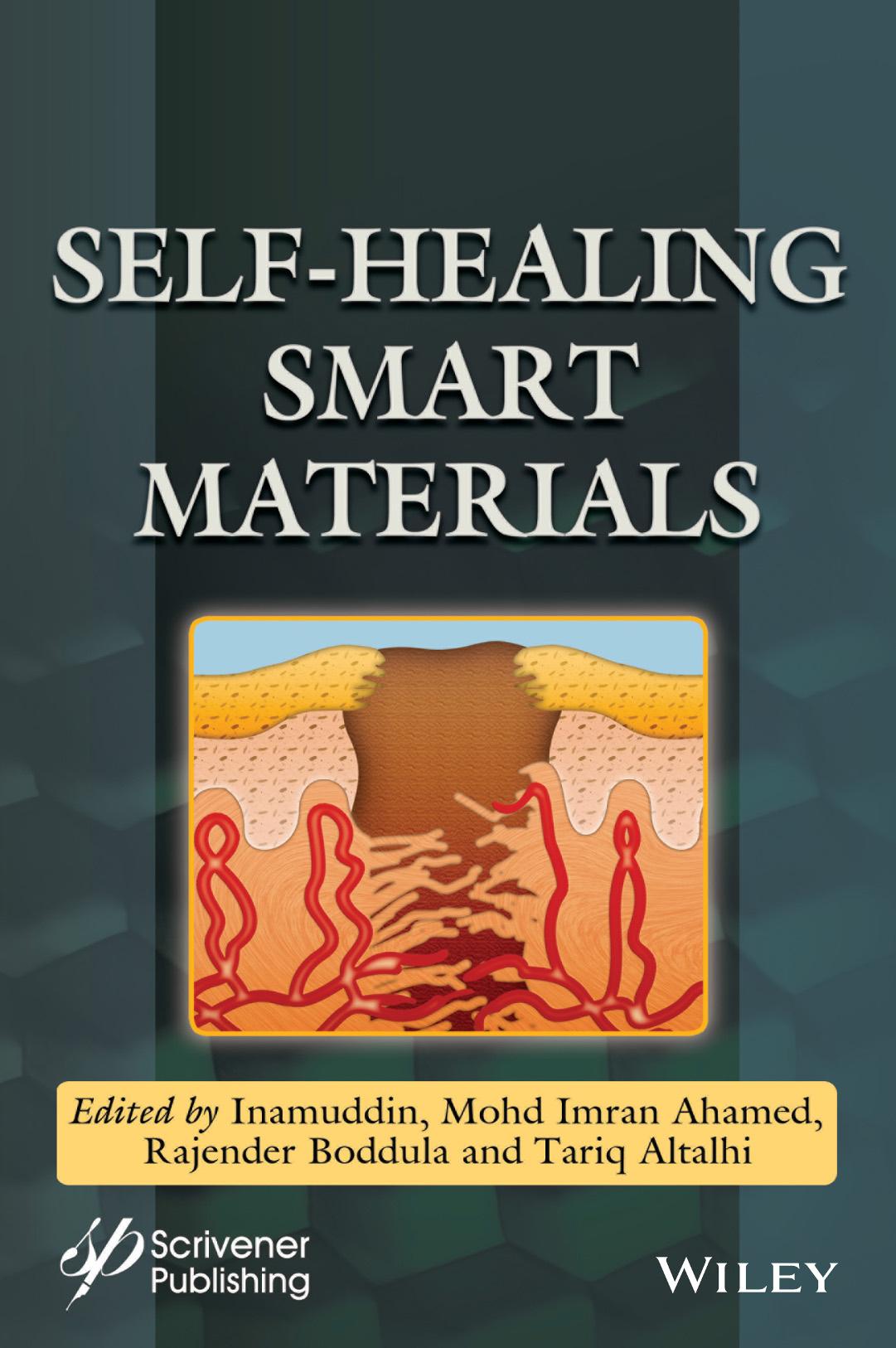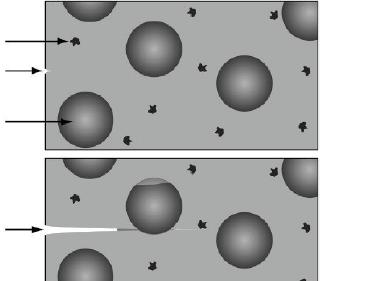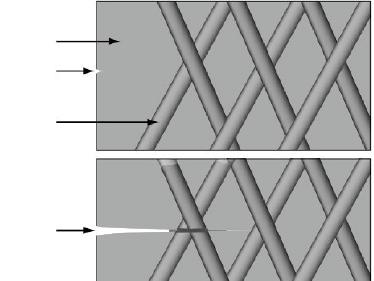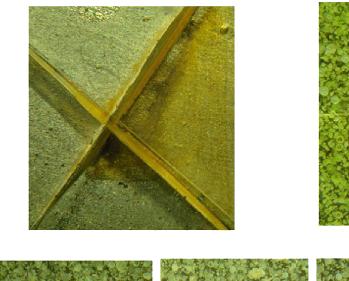Self-Healing Smart Materials and Allied Applications
Edited by Inamuddin, Mohd Imran Ahamed, Rajender Boddula and Tariq Altalhi
This edition first published 2021 by John Wiley & Sons, Inc., 111 River Street, Hoboken, NJ 07030, USA and Scrivener Publishing LLC, 100 Cummings Center, Suite 541J, Beverly, MA 01915, USA © 2021 Scrivener Publishing LLC
For more information about Scrivener publications please visit www.scrivenerpublishing.com.
All rights reserved. No part of this publication may be reproduced, stored in a retrieval system, or transmitted, in any form or by any means, electronic, mechanical, photocopying, recording, or otherwise, except as permitted by law. Advice on how to obtain permission to reuse material from this title is available at http://www.wiley.com/go/permissions.
Wiley Global Headquarters
111 River Street, Hoboken, NJ 07030, USA
For details of our global editorial offices, customer services, and more information about Wiley products visit us at www.wiley.com.
Limit of Liability/Disclaimer of Warranty
While the publisher and authors have used their best efforts in preparing this work, they make no representations or warranties with respect to the accuracy or completeness of the contents of this work and specifically disclaim all warranties, including without limitation any implied warranties of merchantability or fitness for a particular purpose. No warranty may be created or extended by sales representatives, written sales materials, or promotional statements for this work. The fact that an organization, website, or product is referred to in this work as a citation and/or potential source of further information does not mean that the publisher and authors endorse the information or services the organization, website, or product may provide or recommendations it may make. This work is sold with the understanding that the publisher is not engaged in rendering professional services. The advice and strategies contained herein may not be suitable for your situation. You should consult with a specialist where appropriate. Neither the publisher nor authors shall be liable for any loss of profit or any other commercial damages, including but not limited to special, incidental, consequential, or other damages. Further, readers should be aware that websites listed in this work may have changed or disappeared between when this work was written and when it is read.
Library of Congress Cataloging-in-Publication Data
ISBN 978-1-119-71015-8
Cover image: Pixabay.Com
Cover design by Russell Richardson
Set in size of 11pt and Minion Pro by Manila Typesetting Company, Makati, Philippines
4.1
3.3.2
5.1
5.3
5.4
5.2.2
5.4.2
5.4.3
5.4.5
5.5
5.2.2.1
5.2.2.3
6
Seyyed Alireza Hashemi, Seyyed Mojtaba Mousavi, Sonia Bahrani, Seeram Ramakrishna, Chin Wei Lai and Wei-Hung Chiang
6.1 Introduction
6.2
6.2.1
6.2.2
6.2.3
6.3 Advanced
6.4
6.5
6.6
7
Sonia Bahrani, Seyyed Mojtaba Mousavi, Seyyed Alireza Hashemi, Chin Wei Lai and Wei-Hung Chiang
7.1
7.2
7.3
7.3.1
7.4 Methods of Fabrication of Self-Healing Core–Shell Nanofibers
7.4.1 Co-Electrospinning
7.4.2
7.4.3 Solution‐Blown
7.5 Self-Healing in Laminated
7.6 Beneficial Self-Repairing Systems on Basis of Core–Shell Nanofibers
7.7
8 Intrinsic Self-Healing Materials
Angelita Cristiane Saul and João Henrique Zimnoch dos Santos
8.1 Introduction
8.2 Inverse Reactions and Chain Recombination
Ramesh, L. Rajeshkumar, D. Balaji, V. Bhuvaneswari and S. Sivalingam
15
14.4
M. Ramesh, L. Rajeshkumar and R. Saravanakumar
M. Harikrishna
Kumar, R. Rajasekar and V. K. Gobinath
18.5.4
Seyyed Mojtaba Mousavi, Maryam Zarei, Seyyed Alireza Hashemi, Wei-Hung Chiang, Chin Wei Lai and Sonia Bahrani
19.1
19.2
19.3
Lutfur Rahman, Ata Ullah, Muhammad Bilal Yazdani, Muhammad Irfan, Waheed S. Khan and Asma Rehman
20.1
20.2 Intrinsic and Extrinsic
20.3
20.3.2
20.3.3
20.4 Healing Agents, Comparison With Biological Phenomenon and Bleeding Mechanism in Self-Healing
20.4.1 Compartmentalization, Recovery After Yield and Reinforce
20.5 Advantages and Disadvantages of Self-Repairing Bleeding
20.6
21 Self-Healing Polymers
Muhammad Akram, Charles Oluwaseun Adetunji, Mohd Imran Ahamed, Adrish Sohail, Iram Ghaffar, Olugbenga Samuel Michael, Hina Anwar, Musa Abidemi Muhibi, Juliana Bunmi Adetunji, Umme Laila and Mathew Olaniyan
21.1 Introduction
21.2 General
21.3
21.5
21.3.5
21.6
21.5.2 Extrinsic Self-Healing 522
21.5.3 One Capsule System 522
21.5.4 Self-Healing Based on Ring Opening Metathesis Polymerization 522
21.5.5 Solvent-Induced Self-Healing 523
21.5.6 Dual-Capsule Systems 523
21.5.6.1 Polydimethylsiloxane Condensation 524
21.5.6.2 Platinum-Catalyzed Hydrosilylation 524
21.5.6.3 Adaptive Resistant Effect 524
Preface
There is apprehension about the undesirable material damage caused in devices by breakage, operational fatigue, volume change, abrasion, shape deformation, and cutting eventually formed during practical usage and degradation over time, resulting in deterioration of device properties. This mechanical damage of devices will reduce their reliability and shorten their lifespan. Thus, the development of suitable materials with self-healing, electrical and ionic properties to overcome the damage is very much the need of the hour. Self-healing smart materials (SHSMs) are one of the smart materials that can automatically restore some or all of a devices’ functions after suffering external mechanical damage or harsh environments. In particular, because of their wide-ranging practical applications, SHSMs are having a significant impact in industry due to the self-healing capabilities of the material, which can expand the service life, operational life, longevity, and reliability of the devices; and also reduce waste, thereby conserving resources. The advancement of wearable electronic devices which use self-activating and self-adjusting systems are promising for enhancing operational safety and lifespan. Moreover, the use of SHSMs in manufacturing devices is an excellent choice to re-establish electrical and mechanical properties in case of a mechanical failure. Hence, an understanding about “self-healable technology” and all its related concepts is very essential for modern industries and research communities since these SHSMs and their composites are having a great impact on modern wearable applications in energy and environmental science.
This book describes the design, synthesis, mechanisms, characterization, fundamental properties, functions and development of SHSMs and their composites with their associated applications. It covers cementitious concrete composites, bleeding composites, elastomers, tires, membranes, and composites in energy storage, coatings, shape-memory, aerospace and robotic applications. This book is a result of the commitment of top researchers in the field with various backgrounds and expertise. Its target audience includes materials scientists, polymer industrialists, researchers,
members of R&D in wearable electronics; as well as university professors, postgraduate students and academics who are working and studying in the fields of polymers, chemical technology, biology, advanced electronics, polymer engineering, aeronautical engineering. mechanical engineering, biomedicine, advanced sciences, materials sciences, flexible energy storage, and renewable energy. A summary of the information covered in the 21 chapters is given below.
Chapter 1 describes the most recent and relevant advances in the development of self-healable polymer coatings, both extrinsic (those using external healing agents) and intrinsic. Implementation of new strategies, like remote activation of the healing process, as well as the perspectives and challenges for these innovative materials, are also discussed.
Chapter 2 overviews the current progress on the synthesis of benzoxazine-based materials for self-healing and shape-memory applications. The advantages and drawbacks of these materials are also discussed. Many examples are provided regarding the design flexibility of benzoxazine chemistry and its vast potential in designing smart materials.
Chapter 3 introduces the characteristics of self-healing in elastomers and techniques for characterization of healing ability. It also reviews self-healing in particular cases of different elastomer matrices such as natural rubber (NR), styrene butadiene rubber (SBR), polybutadiene rubber (BR), bromobutyl rubber (BIIR), silicones and polyurethane (PU).
Chapter 4 discusses various promising strategies for fabricating selfhealable rubber as well as methods to improve the self-recovery properties of the rubber. In addition to that, the chapter also focuses on natural rubber modification with self-healing properties, as it has become the most critical component in manufacturing self-healable tires.
Chapter 5 outlines the self-healing methods for concrete composites in general, and details about bacterial-aided, self-healing in particular. The different mechanisms of bacterial self-healing and the factors influencing it are discussed. Strategies to enhance the performance of the healing, as well as methods employed for testing are also included.
Chapter 6 focuses on an ideal and long-lasting photovoltaic device which can heal all of the damages applied to its structure to decrease maintenance costs of solar panels. The current self-healing mechanisms and recent progress in solar cells are summarized.
Chapter 7 provides additional insights into the construction of self‐healable core-shell nanofiber agents and their potential application in various areas.
Chapter 8 details the state-of-the-art in intrinsic self-healing smart materials. It summarizes some of the most significant research on SHSMs.
Future challenges that need to be overcome to enable commercial exploration of systems already developed are also discussed.
Chapter 9 discusses self-healable materials in the field of catalysis. The basics and application areas of catalysts that are reported in the literature are covered. Additionally, some specific energy fields, such as oxygen evolution and hydrogen generation catalysts, are discussed in detail.
Chapter 10 details the recent advances regarding the potential applications of various types of micro/nano-carriers of healing agents for the development of smart/intrinsic self-healing anti-corrosion polymeric coatings. The SHSMs/fillers classification, various techniques used to load inhibitors into carriers/containers, and their release/corrosion-inhibition mechanisms are introduced and conceptualized.
Chapter 11 discusses the various methods of self-healing for conductive materials. Self-healing conductive materials, such as elastomers, reversible bonds, polymers, capsules, liquids and composite, are discussed. The complex conductivity which can be established even as a coating is also discussed.
Chapter 12 deals with the preparation and properties of self-healable electronic skin. Its various applications as a pressure sensor and body motion sensor are discussed. Artificial skin can also be used for electrocardiogram and electromyograph monitoring, as well as for monitoring Parkinson’s tremor.
Chapter 13 overviews self-healing smart composite materials and their different self-healing mechanisms. These materials are designed based on two approaches: (a) discharge of smart self-healing agents towards the generated damage and (b) alterable crosslinking networks.
Chapter 14 overviews the stimuli-responsive self-healable materials. It provides details about the history, different types and importance of self-healable materials. The major focus is on recent examples of selfhealing polymers that show response to various stimuli. The chapter ends with a discussion about aspects concerning the commercialization of SHSMs and challenges in the area.
Chapter 15 covers mechanically-induced SHSMs with novel characteristics for numerous applications. Various methods of producing these mechanically-induced SHSMs based on different types of materials are discussed.
Chapter 16 discusses SHSMs, their method of synthesis, and application in robotics. The focus of the chapter is on describing the chemistry of self-healing and the working principles. The various approaches of self-healing are also explained such as capsule-based, vascular, and intrinsic self-healing systems. The major focus is on the application of the
material in the different sections of soft robots such as skin, actuator, electronics, and sensor.
Chapter 17 discusses the various methods of developing SHSMs for aerospace structural and high-temperature applications. Materials like fiber-reinforced polymers that alter the nature of the base matrix and ceramic matrix composites are described in detail along with intrinsic and extrinsic self-healing mechanisms.
Chapter 18 presents bioinspired, magnificent, nature-based, broadscope elements with numerous functions. These elements exhibit immense power to perceive, respond, and self-heal (autonomous healing). The discussion proceeds with a brief insight into SHSMs, coatings, their types, and the exploitation process used to extract their characteristic features to benefit humankind. This chapter sheds more light on examples dealing with self-healable materials with a notion to fabricate such self-healable materials with rapid exploration and a promising platform.
Chapter 19 introduces SHSMs as promising candidates for the fabrication of electronic devices, energy storage systems, and even sensors. The progress made in SHSMs research is detailed and the preparation mechanisms and properties of the self-healing processes are summarized. In terms of self-healing batteries, both macroscopic and microscopic SHSMs are introduced.
Chapter 20 focuses on self-healing in bleeding engineered composite structures. Additionally, materials with intrinsic and extrinsic self-healing properties are discussed. Moreover, various strategies like bioinspired, biomimetic and vascular networks, are described in detail. Also discussed are approaches for the synthesis of bleeding composite structures, along with their evolved properties, repairing mechanism, disadvantages, and advantages.
Chapter 21 provides a general overview of numerous materials with self-healing attributes. Greater emphasis is also placed on autonomic and non-autonomic types of SHSMs. The mechanism of action of these SHSMs are also highlighted.
Inamuddin, Mohd Imran Ahamed, Rajender Boddula and Tariq Altalhi March 2021
Self-Healing Polymer Coatings
Facundo I. Altuna* and Cristina E. Hoppe†
Instituto de Investigaciones en Ciencia y Tecnología de Materiales (INTEMA), Universidad Nacional de Mar del Plata—CONICET, Mar del Plata, Argentina
Abstract
Traditional coatings made of thermosetting polymers could not be healed or mended because of their cross-linked structure, so damage implied the end of their service life cycle. This picture has dramatically changed since the first self-healing systems reports, moment in which this “disadvantage” of thermosets has started to vanish with the continuous increase in the availability of self-healing and recyclable thermosetting polymers. These advances constitute a breakthrough, as they would avoid replacement and catastrophic failure, encourage recycling and re-processing and prevent the generation of a considerable amount of waste, with obvious environmental and economic benefits. This chapter describes some of the more recent advances in the field of self-healing thermosetting polymers with potential application as coatings. Extrinsic self-healing thermosets use an external agent to perform the healing whereas intrinsic ones require the intervention of an external trigger for repair damage. The first part of the chapter describes the work in extrinsic self-healing thermosets, and the second part in intrinsic ones, with emphasis on polymeric networks with dynamic covalent bonds (DCBs). The most common strategies for the external triggering of intrinsic self-healing polymers are also described. Finally, challenges are discussed with the aim put in attaining the so expected end-user applications.
Keywords: Self-healing, thermosets, dynamic covalent bonds (DCBs), coatings, crosslinked polymers
*Corresponding author: faltuna@fi.mdp.edu.ar; facundoaltuna@gmail.com
†Corresponding author: hoppe@fi.mdp.edu.ar; cristinaehoppe@gmail.com
Inamuddin, Mohd Imran Ahamed, Rajender Boddula and Tariq Altalhi (eds.) Self-Healing Smart Materials and Allied Applications, (1–38) © 2021 Scrivener Publishing LLC
1.1 Introduction
Traditionally, materials science and technology research has been a quest for improving one or several properties of any given class of materials, so that they can have an enhanced performance. With this aim, all kinds of materials from ceramics and metals to glasses and soft polymers are nowadays designed based on strong scientific knowledge. However, during their service life, materials can suffer damages with consequences that range from affecting the way in which the materials are supposed to work to catastrophically break down or, in the case of a damaged coating, leaving the substrate deprived from its protection. In such cases, besides all the relevant physicochemical, mechanical, thermal and other properties, it would be highly desirable that the material could be mended. Doing so, it would avoid its replacement and save lots of time and economic resources. It would also prevent the generation of a considerable amount of waste, with obvious environmental and economic benefits. With this purpose, the development of self-healing polymers is gaining momentum since the first works studying healing mechanisms in polymers were published about 40 years ago [1, 2]. Another leap forward followed with the design of self-healing polymeric systems containing vessels with healing agents [3, 4], which demonstrated autonomous healing ability.
Thermosetting polymers constitute one of the two great polymer groups according to the most usual polymers classification. They distinguish themselves from thermoplastic polymers—which form the other group—by their crosslinked structure, which provides them with a set of distinctive properties, such as an improved resistance to solvents and chemical reagents, good mechanical strength and thermal stability [5]. Owed to these properties their use as protective coatings, among other applications, has become very popular. Unfortunately and also because of its crosslinked structure, typical thermosetting polymers cannot be healed. This is their main disadvantage in comparison with thermoplastics, which can be not only healed but also reprocessed and recycled by applying the proper processing that often includes a thermal treatment [6, 7]. These differences, however, are starting to vanish, as proved by the continuously increasing number of systems based on self-healing and recyclable thermosetting polymers appearing in the scientific literature. The relevance of the role that self-healing materials and recyclable thermosets are called to play has been already highlighted by the World Economic Forum, which listed them among the Top 10 Emerging Technologies in 2013 and 2015 respectively [8, 9].
In this chapter, we will describe some of the more recent advances in the field of self-healing thermosetting polymers with potential application as coatings. One of the most popular classification of self-healing thermosets is between extrinsic and intrinsic healing systems [10, 11]. The category of extrinsic self-healing thermosets encompasses all those systems that make use of an external agent to perform the healing of the damage. The self-healing composites with hollow microspheres or microfibers filled with a repairing agent, usually a thermosetting polymer precursor, are the most common examples. The healing mechanism of these materials intends to mimic how nature acts to heal wounds in animals, through a vascular system that delivers the healing agent. The healing process in polymers starts when a crack propagates through it and breaks the vessels that contain the repairing agent, which is released within the crack. At this moment, the repairing agent comes in contact with a catalyst dispersed in the matrix and reacts, forming a new polymeric network that fills the crack, restoring the mechanical properties to the material. To this group belong the first developed self-healable polymers [3, 4, 12, 13]. Figure 1.1 shows schematically the concept of extrinsic self-healing thermosetting polymers.
The other large group is formed by those self-healing polymers that do not require the intervention of an external healing agent. There are some
Figure 1.1 Concept of healing mechanisms in microcapsule- (left column) and hollow fiber- (right column) based self-healing composites. Extrinsic polymeric composites. Adapted from Ref. [14]; Copyright (2008) with permission from Elsevier.
Grubbs Catalyst Bulk Material
Propagating Crack Tip Fibres Filled with Healing Agent
Crack Being Filled with Healing Agent Solid Wedge in Crack Formed after Healing Agent Solidi es
Solid Wedge in Crack Formed after
Contacted Grubbs Catalyst
4 Self-Healing Smart Materials and Allied Applications
examples of mixtures of thermoplastics and thermosets, either homogeneous or with a multi-phase structure, that use respectively the entanglements of dangling chains or the melted thermoplastic to mend an eventual crack [15, 16]. The majority of the reported intrinsic self-healing thermosets, however, are based on either reversible or dynamic covalent bonds. During healing, such crosslinked polymers are depolymerized or undergo a topological rearrangement, depending on whether the bonds that form the macromolecule are of reversible, or of dynamic nature [17–19]. In both cases, when the healing is produced the same polymer acts as its own healing agent. The disadvantage of most intrinsic self-healing polymers is that they need an external stimulus—such as heat, light or a mechanical stress—to induce the healing. Figure 1.2 shows schemes of the aforementioned intrinsic self-healing thermosets.




Figure 1.2 Intrinsic healing mechanisms for thermosetting polymers. (a) Homogeneous mixtures of thermosetting and thermoplastic polymers. Reprinted with permission from Ref. [14]. Copyright (2008) with permission from Elsevier. (b) Heterogeneous mixtures of thermosetting and thermoplastic polymers. Reprinted with permission from Ref. [15]; Copyright (2009) American Chemical Society. (c) Polymeric networks based on reversible covalent bonds. Reproduced with permission from Ref. [20]. Copyright (2008) John Wiley & Sons, Inc. (d) Polymeric networks based on dynamic covalent bonds. Adapted with permission from Ref. [21]. Copyright (2012) American Chemical Society.
Prepolymer + Linker
Bricks/mor tar morphology
“Bleeding” of PCL
Other characteristics of the self-healing coatings are also of critical relevance for their final applications. Perhaps the most important one regards the stimulus needed for the self-healing process to start, ranging from materials that need no stimulus to the cases where high temperatures or external stresses have to be applied. This would be another valid classification for self-healing materials, but as we will find out, very often the limit between them is somewhat blurred. In most cases extrinsic self-healing polymers are totally or nearly autonomous, and intrinsic ones need an external triggering. That is, most intrinsic self-healing coatings should not be regarded as self-healing, but instead just as healable materials. There are as well some notable exceptions to this statement that deserve to be considered.
Extrinsic self-healing polymers were developed several years before that intrinsic ones. However, nowadays intrinsic self-healing polymers are a much faster growing research field, led by polymeric networks based on dynamic covalent bonds (DCBs). We will devote the first part of this chapter to extrinsic self-healing thermosets, and a second part to intrinsic ones, with special emphasis on polymeric networks with DCBs. Finally, we will provide a perspective for future trends regarding self-healing polymeric coatings.
1.2 Extrinsic Self-Healing Polymer Coatings
The most widely explored extrinsic self-healing polymers are systems based on composites containing the healing agent into purposely designed containers that break when the material is damaged. Usually, their selfhealing is autonomous, needing no other driving force than the damage itself, or in some cases the action of the surrounding environment. The key for the self-healing to take place autonomously is that the chemical precursors released can readily react at the material’s operation temperature. Quite often this is room temperature, and hence these polymeric composites must be designed in order to carry the appropriate amount of catalyst to complete the curing reaction at this low temperature. Besides this, other relevant aspects of the healing mechanism need to be accounted to achieve high healing efficiencies. The vessels containing the healing agents must break, and the healing agents have to flow to fill the crack before the curing reaction produce its gelation. Hence, a good load transfer from the matrix to the vessels combined with the specific fracture toughness of the vessels is needed, and the viscosity of the healing agents must be low enough to allow them to flow into the crack. These features have also been addressed in several previous works [22].
There are several monomers and catalysts that allow reaction rates high enough to achieve self-healing at room temperature. Grubbs catalysts are one of the most widely used for autonomous self-healing composites based on microencapsulated healing agents. It was first proposed for self-healing composites by White et al., to aid the crosslinking of dicyclopentadiene (DCPD) through a ring opening metathesis polymerization (ROMP) [12]. The DCPD was contained into urea microcapsules embedded within these composites, and the Grubbs catalyst was dispersed in the matrix. After healing during 48 h at room temperature, the researchers observed that the healed sample reached a load of 75% of that of the virgin sample in a fracture test. These results were very promising, and the healing efficiency values were quickly surpassed in the following years by similar systems that incorporated some improvements in their formulations and/or their processing [23, 24]. By protecting the catalyst with wax [25] a considerable raise in the healing efficiency was achieved, thanks to an enhanced stability of the catalyst, but this modification was also associated with a decrease in the damage resistance to impact. These systems were also used to study the effect of the particles’ size and load on the healing efficiency, which allowed to determine that microcapsules smaller than 30 mm are efficient for small cracks (around 3 mm), but larger capsules and higher loads are needed for larger cracks [26].
However, some shortcomings of the DCPD-Grubbs catalyst systems (low long term stability due to possible side reactions with air and the polymer matrix) [27], encouraged the search for other chemistries that could overcome these difficulties. The condensation of hydroxy capped polydimethylsiloxane (HOPDMS) and polydiethoxysiloxane (PDES) with dibutyltindilaurate (DBTDL) in a vinyl ester matrix showed an improved stability, but the healing efficiencies were rather poor [27]. Much better results were observed for a polydimethylsiloxane (PDMS) elastomer filled with poly(urea-formaldehyde) (UF) microcapsules containing the same precursor and Pt initiator used to synthesize the PDMS matrix separately [28]. The authors studied the breaking mechanism of the capsule, and provided an interesting insight from the observation of the process of deformation and failure of a microcapsule within the elastomeric matrix. The sequence is shown in Figure 1.3. For stretch values below 1.5 the microcapsule is deformed along with the matrix, withstanding the stress, but for higher deformations, the failure of its wall releases the chemical precursors. This study focused on some very important aspects of the use of microcapsules for self-healing composites, such as the microcapsule rupture process, and how its presence affects some properties of the matrix. It clearly showed that the breaking of the capsules is a quite complex matter,



Figure 1.3 Images of a single PDMS microcapsule subjected to uniaxial tension at different values of deformation (γ). Reprinted with permission from Ref. [28]. Copyright (2007) John Wiley & Sons, Inc.
and even brittle materials (when evaluated in bulk) such as UF may need relatively high strain values to fail [28, 29]. The authors also observed an improvement on tear strength with the increase in the microcapsules concentration (up to 20 wt% of microcapsules), which is in agreement with previous results for reinforced PDMS [30, 31]. To ease the flow of the healing agent off the microcapsules and into the crack, its viscosity was reduced by using heptane as diluent [28]. Using a similar system, consisting in a silanol-terminated polydimethylsiloxane (STP) as healing agent and dibutyltin dilaurate (DTDL) as catalyst, Kim et al. obtained a self-healing coating that could repair itself at temperatures as low as −20 °C. The viscoelastic material produced by the healing agent was capable of protecting the coated and scratched specimens from saline solution uptake upon immersion for 48 h at −20 °C [32].
Microencapsulated epoxy precursors were also applied as external healing agent in matrices with a dispersed latent initiator [33–37]. Yin et al. utilized UF microcapsules containing an epoxy resin based on diglycidyl ether of bisphenol A (DGEBA), and a latent catalyst consisting in a complex of CuBr2 and 2-methylimidazole (MeIm), dispersed in the matrix [33]. Their results showed very good healing efficiencies, with healed specimens showing fracture toughness values 11% higher than those of the virgin
samples. As the authors explained, this is a side effect of the higher fracture toughness of the resin used as healing agent when compared to the matrix, probably due to the higher temperature and/or the different curing mechanism of the healing reaction: the samples were synthesized at temperatures up to 100 °C, and the subsequent healing was performed at 130 °C. They also applied the self-healing matrix to the synthesis of self-healing epoxy laminates, using glass fibers [33, 34]. However, the healing efficiencies were lower in this case, and an important downside of the use of microcapsules was the reduction of the tensile properties for microcapsule loads above 30 wt% [34]. Guadagno et al. assessed the healing efficiency and the mechanical properties of self-healing epoxy systems with different flexibilizers [36, 37]. When the curing temperature of these systems was raised from 170 to 180 °C, the mechanical moduli increased, but the healing efficiency slightly decreased, probably due to an initial thermolytic decomposition of the Hoveyda–Grubbs’ first generation catalyst. Interestingly, the replacement of the Heloxy71 used as flexibilizer by the reactive diluent 1,4-butanedioldiglycidylether (BDE) leads to an increase in the compressive modulus, from around 0.7 to 1.4 GPa, with no loss in the healing efficiency (above 80%) [37]. Hia et al. demonstrated multiple self-healing ability in epoxy composites with alginate multicore microcapsules [38]. Three to four healing cycles were produced, though the efficiencies were around 55%, which are lower than for other systems. Moreover, the authors found that self-healing specimens have lower impact strength than the neat epoxy polymers, due to the large size of the capsules, and its high load.
Polyurethanes (PU) were explored for extrinsic self-healing systems [39, 40]. He et al. used isophorondiisocyanate (IPDI) encapsulated into polyurea capsules as self-healing agent for PU matrices and also for epoxybased ones [41]. They show that complete healing (efficiencies around 100%) of both epoxy and PU matrices is achieved for capsules with diameters of 96 mm or higher. Smaller capsules produced poorer healing performances. Gil et al. used microencapsulated diisocyanate to improve the tensile strength of collagen [42]. They used two different diisocyanates: IPDI and 4,4’-diphenylmethane diisocyanate (MDI); the isocyanate groups react with the collagen, creating new crosslinks and mending the damages. Other healing agents employed for extrinsic self-healing coatings, including thiol-ene and azide-alkyne precursors, as well as vinyl ester and unsaturated polyesters have also been tested, as pointed out in a review by Hillewaere and Du Prez [43].
A smart approach proposes to develop self-healing systems especially designed so that the healing can be activated by the environment surrounding the material when a crack propagates. Different research groups
used encapsulated isocyanate that reacts with water when released into aqueous environments, producing coatings with potential applications in offshore and other marine devices. Di Credico et al. also used encapsulated IPDI to provide self-healing capacity to a DGEBA-based epoxy matrix, thanks to the crosslinking reaction of isocyanate with the surrounding water [44]. Figure 1.4-I shows the damaged coating, and the healed coating after immersion for 48 h in salty water. The authors emphasized that the rough outer surface of the microcapsules played a key role improving the adhesion to the matrix, allowing the capsule to fail and release the IPDI. Wang et al. also used IPDI as healing agent to repair cracks in an alkyd varnish coating (AVC) [45]. Figure 1.4-II shows the aspect of the mended scratch on different substrates after different times of exposure to marine salty water. Though some seawater could penetrate into the coating and reach the substrate, the self-healing prevented a much larger damage. Light is another possible external stimulus that can be harnessed to trigger the healing response. Sunlight was proposed by some authors to induce the self-healing of polymeric coatings. Song et al. designed the first



Figure 1.4 (I)—SEM micrographs of crack in a coating with PU/PUF microcapsules (a) before and (b) after immersion in salt water for 48 h. Reprinted from Ref. [44]; Copyright (2013) with permission from Elsevier. (II)—Alkyd varnish coatings on a titanium surface after 200 and 1,200 h of seawater immersion. Reprinted from Ref. [45] with permission from The Royal Society of Chemistry.
photoinduced microcapsule-based self-healing coating from tetraethyl ortosilicate and a polysiloxane, with encapsulated methacryloxypropylterminated polydimethylsiloxane (MAT-PDMS) and benzoinisobutyl ether (BIE) photoinitiator [46]. The conversion of the healing agent upon exposure to real sunlight was somewhat lower than when an artificial UV light was used instead. However, several tests (optical and SEM examination, and measurements of water uptake and chloride ion penetration) showed that relatively short times (4 h) of sunlight exposition are enough to produce an acceptable healing. Figure 1.5 shows the results obtained, comparing the performance of the self-healing coating with the control coating (without the encapsulated healing agent). Khalaj Asadi et al. successfully encapsulated a sunlight curable silicon based resin, and studied several parameters affecting some final properties of the capsules [47]. They used polyvinylpyrrolidone as emulsifier, and established the optimum amount to obtain higher yields. These capsules showed good resistance to water and xilene, but ethanol produced a rapid deterioration of the microcapsules. The authors remarked that these microcapsules can be readily used for self-healing polymers formulations.
The use of UV light to trigger the mending reactions was explored as well by other researchers. Gao et al. encapsulated a photosensitive resin obtained from a mixture of Bisphenol A epoxy resin diacrylate ester (BAEA) and trimethylolpropane-triacrylate (TMPTA) with 1-hydroxycyclohexyl-phenyl-ketone into UF capsules, and embedded them into an epoxy-amine matrix [48]. The microcapsules were synthesized containing TiO2 in its shell in order to absorb the UV light and protect the photosensitive resin into the undamaged capsules from curing before being released. Anticorrosion tests were performed after scratching the samples and healing during 30 s with UV irradiation. The neat epoxy-amine matrix and a composite with capsules without TiO2 were used as control (CC1 and CC2 respectively). Corrosion was observed in CC1, but CC2 and the selfhealing coating could protect the steel substrate. When the experiment was repeated with a new scratch on the same samples, CC2 could no longer protect the steel, and corrosion was observed. Figure 1.6 shows the images of the samples after each test. For the self-healing coatings, the experiment was repeated 5 times, and the self-healing ability was eventually lost after 5 irradiation events. SEM images of the scratch and the electric current measured for each case confirmed the previous observations.
Zhu et al. also used a UV-curable healing agent into microcapsules with a rapidly degradable inner polymeric shell and an outer TiO2 shell that can absorb UV radiation [49]. The action of the TiO2 shell helps to degrade the inner shell, releasing the healing agent. Hence, the self-healing composite
Figure 1.5 (I)—Scheme of the sunlight induced healing mechanism: the crack breaks the microcapsules and release the healing agent, which undergoes the crosslinking reaction upon exposure to sunlight. (II)—Water uptake measurements for the plain mortar, and mortars coated with the control and the self-healing coating. (III)—Chloride penetration tests. Current vs. elapsed time, and accumulated charge during 6 h for the undamaged control coating (a), scribed control coating (b) and scribed and healed self-healing coating (c). Reprinted with permission from Ref. [46]. Copyright (2013) American Chemical Society.
Figure 1.6 Steel substrates coated with (a) CC1, (b) CC2 and (c) self-healing coating, after successive scribing and healing sequences. Reprinted with permission from Ref. [48]; Copyright (2015) American Chemical Society.
displays a dual release mechanism that enhances its efficiency. The microencapsulated healing agent consisted in an epoxy silicone with a photosensitive initiator (triarylsulfonium hexafluorphosphate salt) and the matrix was based in silicone resins. Figure 1.7 shows a scratch on the coatings after 12 h of UV irradiation. The comparison was made using composites with microcapsules without the healing agent (labeled as “BS-xx”), and composites prepared with capsules filled with the healing agent but unable to fail and release it by UV irradiation, due to a low concentration of TiO2 NPs in its outer shell (labeled as “CS-xx”). The self-healing coatings were labeled as “SH-xx”. The numbers xx represent the wt% of microcapsules. The effect of the healing agent released within the crack is very clear, and for a microcapsules load of 60 wt% the healing seems to be excellent. Some drawbacks of the use of microcapsules/hollow microfibers are worth to mention. Samadzadeh et al. [50] have mentioned some of them, including the negative side effects on the mechanical properties of the material, such as Young’s modulus and ultimate stress [50, 51]. Adhesive properties can also suffer a decrease due to the presence of microcapsules [50]. In most cases a compromise between an acceptable healing with a minor deterioration of the resistance has to be reached. Additionally, there are some aspects that should not be overlooked when designing a selfhealing composite based on the dispersion of microcapsules with a healing agent in a polymeric matrix. The adhesion between the capsule and


